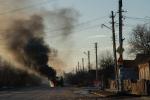
Perhaps Not a World War, But One That Should Concern Us All: The War in Ukraine From a Vietnamese Perspective
I was born in Lao Cai, a town at the border with China. When I look across the Red River I see the advertisements in Chinese characters in the Chinese town Hekou. I would not have been here today writing these words if on that misty cold morning of 17 February 1979 my mother had been hit by the Chinese artillery shelling that destroyed her house in Lao Cai. Like all the Vietnamese towns and villages along the Sino-Vietnamese border, Lao Cai was reduced to rubble in the 1979 China invasion of Vietnam. The women and children of Lao Cai fled, while all able men stayed on to fight. Many families were never reunited. In North Vietnam, people of my generation are known as “babies who fled the Chinese with their mothers” (thế hệ chạy tàu).
Historical parallels
The Russian invasion of Ukraine resembles the Chinese invasion of Vietnam in 1979 in several ways. Until recently, the Ukrainians were the “brothers” of the Russians. They share a history and significant parts of their culture with the Russians. Similarly, the Chinese and the Vietnamese were brothers, communist allies against American aggression. They also share a Sinitic civilizational history. The independent course that the Vietnamese were taking in Cambodia, namely attacking and overthrowing the China’s backed genocidal Khmer Rouge regime, angered Chinese leaders. The war that China waged against Vietnam in 1979 was China’s way to teach Vietnam a lesson about who was the boss in this part of the world. The invasion was relatively short, just 17 days, but parts of North Vietnam were destroyed, tens of thousands died, and military border conflict continued for ten years.
The Vietnamese general distrust of Chinese actions and intentions has continued until today. It flares up again in the current South China Sea conflicts that involve China, Vietnam, and also several Southeast Asian nations. Back in the 1979, the Chinese pretext for their military intervention was to protect ethnic Chinese citizens of Vietnam. Today, the Russian pretext is to protect ethnic Russians in Ukraine. The Chinese objective was also to warn the Vietnamese leadership that they could not be independent of China. The Russians want to use force to create a regime change (a concept seemingly derived from the American interventions in the Middle East) and have declared that the only way for Ukraine to avoid human misery is to stay in Russia’s orbit.
Vietnamese refugees
When China invaded Vietnam, the Vietnamese war machine was well-oiled after many battles with the Americans. The Chinese faced a tough opponent, even though the Vietnamese now had two fronts, in Cambodia and North Vietnam. Nevertheless, there is no doubt that Vietnam would not be able to win a military conflict with China, just as much as Ukraine today cannot really win from Russia. What both the Ukrainians and the Vietnamese will do is resist, even when there is regime change. The suffering caused by these attempts to establish supremacy cannot be measured. What we do know is that people vote with their feet. Those who can leave, leave.
The aftermath of the communist unification of Vietnam and the wars with China and Cambodia was an unprecedented Indo-Chinese refugee crisis. Many of the loempia sellers in Dutch cities have fled Vietnam. While these “boat refugees” mostly came from South Vietnam, a simultaneous flow of migrants came from North Vietnam to Eastern Europe, during the Communist period and continuing until today. That is why one finds thriving Vietnamese communities in former East Germany, Poland, Hungary, and so on.
In Ukraine, the estimated number of Vietnamese is 50,000. Like other Vietnamese in Eastern Europe, the Ukrainian Vietnamese benefited from trade in border areas. Their transnational network helps them to supply cheap clothing and other products for large markets in Kiev, Warsaw, Budapest, and (east) Berlin. Having left Vietnam for a better future they have ended up in another war zone. Their informal trade and existence mostly stay under the radar. They are, however, symbols of a grassroots interconnectedness of a globalized post-socialist world. They may have been able to work and live in the informal interstices of that world, but are now roughly reminded that states and their military power still exist.
What will China do?
For people living in South-East Asia, the question is what kind of lesson China will draw from the Russian war in Ukraine. When Putin can just go ahead as usual without dire consequences inflicted by the West, China may interpret this as another sign of the decline of Western power and determination. This would not be good news for the people of Taiwan, but also, more broadly, for the people of South- and South-East Asia. While China is generally quite adamant to support the notion of national sovereignty and non-interference in another state’s affairs, it is silent now.
The only potential alliance for Russia may be with the Chinese, who need gas and oil and are building a financial infrastructure that is independent of the West. The war in Ukraine is not a world war, but it is interpreted throughout the world from the specific concerns of people in different places. For the Vietnamese, this war threatens the Vietnamese community in Ukraine and Eastern Europe, but perhaps more important to them is the impact it may have on Chinese imperial pursuits.
